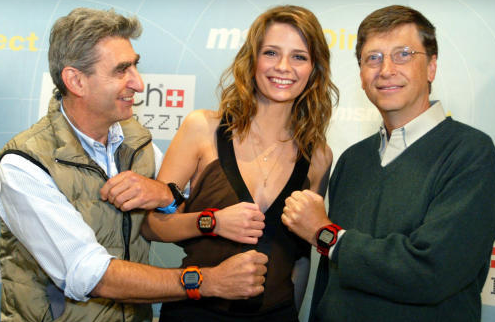[caption id="attachment_9175" align="aligncenter" width="495"]  Bill Gates and celebrities show off the original SPOT timepieces.[/caption] Rumors abound this week that Microsoft is working with its manufacturing partners on a touch-enabled “smart watch.” According to unnamed executives speaking to The Wall Street Journal, Microsoft has “asked suppliers in Asia to ship components for a potential watch-style device.” If the WSJ is accurate, Microsoft is in good company: Apple, Google, Samsung and LG all have timepieces with smartphone-like features in development, according to various reports over the past few weeks. But this isn’t Microsoft’s first foray into wearable-electronics territory. Nearly a decade ago, the company developed Smart Personal Object Technology (SPOT), which was intended to give “everyday devices” such as timepieces some next-generation features. In 2003, it partnered with Fossil to create a SPOT watch capable of displaying everything from sports scores to the weather. (A Wired article from April of that year suggested that Fossil executives “are less concerned with impressing the Slashdot crowd than winning favor with retailers in New York, Tokyo, Paris, and Berlin.”) By 2004, SPOT watches were on the street—and some reviewers weren’t exactly enthused by the concept. “For $130, though, I really wish I could set up RSS feeds or check emails or something on it,” read a Gizmodo post about the Fossil Abacus watch. “I love devices that let me soak in excess information, but only when I get to pick what that information is.” Microsoft had partnered with other watchmakers, including Swatch and Suunto, but the idea failed to seize the popular imagination. Consumers objected to the idea of paying a monthly data-service fee, and the chunky timepieces needed to be charged every couple of days. The technology did attract a small audience of aficionados, but Microsoft aims for the broadest customer base possible—eventually, despite the high hopes for SPOT, the project faded away. But things are different now. Screen technology has advanced to the point where, at least in theory, a manufacturer could build a timepiece with a flexible face, capable of displaying data in intense color, and responsive to touch. Such a device could interface with a smartphone and run a variety of health, navigation, and lifestyle apps. That’s a far cry from the monochromatic LCD displays that defined SPOT watches, and it could be enough to break such wearable technology into the mainstream. Whether or not all these companies actually produce next-generation devices remains to be seen. These rumors could be part of some larger game of chicken, a way to either force rivals to back away from a technology or over-commit to manufacturing a device with little hope of success. But if Microsoft really commits to building a timepiece, it better hope the result has better success than its previous effort. Image: Microsoft
Bill Gates and celebrities show off the original SPOT timepieces.[/caption] Rumors abound this week that Microsoft is working with its manufacturing partners on a touch-enabled “smart watch.” According to unnamed executives speaking to The Wall Street Journal, Microsoft has “asked suppliers in Asia to ship components for a potential watch-style device.” If the WSJ is accurate, Microsoft is in good company: Apple, Google, Samsung and LG all have timepieces with smartphone-like features in development, according to various reports over the past few weeks. But this isn’t Microsoft’s first foray into wearable-electronics territory. Nearly a decade ago, the company developed Smart Personal Object Technology (SPOT), which was intended to give “everyday devices” such as timepieces some next-generation features. In 2003, it partnered with Fossil to create a SPOT watch capable of displaying everything from sports scores to the weather. (A Wired article from April of that year suggested that Fossil executives “are less concerned with impressing the Slashdot crowd than winning favor with retailers in New York, Tokyo, Paris, and Berlin.”) By 2004, SPOT watches were on the street—and some reviewers weren’t exactly enthused by the concept. “For $130, though, I really wish I could set up RSS feeds or check emails or something on it,” read a Gizmodo post about the Fossil Abacus watch. “I love devices that let me soak in excess information, but only when I get to pick what that information is.” Microsoft had partnered with other watchmakers, including Swatch and Suunto, but the idea failed to seize the popular imagination. Consumers objected to the idea of paying a monthly data-service fee, and the chunky timepieces needed to be charged every couple of days. The technology did attract a small audience of aficionados, but Microsoft aims for the broadest customer base possible—eventually, despite the high hopes for SPOT, the project faded away. But things are different now. Screen technology has advanced to the point where, at least in theory, a manufacturer could build a timepiece with a flexible face, capable of displaying data in intense color, and responsive to touch. Such a device could interface with a smartphone and run a variety of health, navigation, and lifestyle apps. That’s a far cry from the monochromatic LCD displays that defined SPOT watches, and it could be enough to break such wearable technology into the mainstream. Whether or not all these companies actually produce next-generation devices remains to be seen. These rumors could be part of some larger game of chicken, a way to either force rivals to back away from a technology or over-commit to manufacturing a device with little hope of success. But if Microsoft really commits to building a timepiece, it better hope the result has better success than its previous effort. Image: Microsoft



